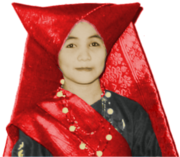ميناڠكاباو (شعب)
ميناڠكاباو أو مناڠكباو Minangkabau هي جماعة عرقية (تُعرف أيضاً بإسم مناڠ أو پدڠ Padang) وهي متوطنة في مرتفعات غرب سومطرة، في إندونيسيا. وثقافتهم تنتسب للأم matrilineal، وتنتقل المواريث والأرض من الأم إلى الإبنة، بينما الشئون الدينية والعلاقات السياسية هي مسئولية الرجال (بالرغم من أن بعض النساء يلعبن أدواراً هامة في تلك الشئون). واليوم يعيش 4 مليون مناڠ في غرب سومطرة، بينما يعيش نحو 3 مليون آخرون مبعثرين في أرجاء إندونيسيا وماليزيا.
 | |
| التعداد الإجمالي | |
|---|---|
| (حوالي 6 مليون) | |
| المناطق ذات التواجد المعتبر | |
| إندونسيا (تقدير 2000) | 5,475,000[1] |
| غرب سومطرة | 3,747,000 |
| رياو | 535,000 |
| شمال سومطرة | 307,000 |
| جاكرتا | 265,000 |
| غرب جاوة | 169,000 |
| جامبي | 132,000 |
| ماليزيا (تقدير 1981) | 300,000[2] |
| اللغات | |
| ميناڠكاباو، الإندونيسية وملايو. | |
| الديانة | |
| الإسلام السني متأثر بالشيعة خصوصاً في پاريامان [3] | |
المناڠكباو متمسون بالإسلام بقوة، إلا أنهم يتبعون أيضاً تقاليدهم العرقية، ويسمونها عادات. وعادات المناڠكباو تنحدر من معتقدات وثنية تواجدت قبل مجيء الإسلام، وبقايا معتقدات وثنية مازالت متواجدة حتى لدى بعض الممارسون للشعائر الإسلامية. العلاقة الحالية بين الإسلام والعادات توصف بالقول "العادات مبنية على الشريعة الإسلامية، والشريعة الإسلامية مبنية على القرآن" (adat basandi syara', syara' basandi Kitabullah).
موطنهم في غرب سومطرة كان موضع حرب پدري من 1821 حتى 1837.
. . . . . . . . . . . . . . . . . . . . . . . . . . . . . . . . . . . . . . . . . . . . . . . . . . . . . . . . . . . . . . . . . . . . . . . . . . . . . . . . . . . . . . . . . . . . . . . . . . . . . . . . . . . . . . . . . . . . . . . . . . . . . . . . . . . . . . . . . . . . . . . . . . . . . . . . . . . . . . . . . . . . . . . .
أصل الكلمة
التاريخ
التأريخ
الثقافة
الاحتفالات والمناسبات
فنون الأداء
المأكل
العمارة
التراث الشفوي والأدب
اللغة
- مقالة مفصلة: ميناڠكاباو (لغة)
| الطائفة | ISO 639-3 | التعداد (في) | اللهجات | ||
|---|---|---|---|---|---|
| ميناڠكاباو | min | 6,500,000 (1981) | Agam, Pajokumbuh, Tanah, Si Junjung, Batu Sangkar-Pariangan, Singkarak, Orang Mamak, Ulu, Kerinci-Minangkabau, Aneuk Jamee (Jamee), Penghulu. | ||
| Source: Gordon (2005).[4] | |||||
أشهر الميناڠكاباو
The Minangkabau are known as the educated society and therefore they are spread across Indonesia and even foreign countries in a variety of professions and expertise such as politicians, writers, scholars, teachers, journalists, and businesspeople. Based on a relatively small population (2.7% of the population of Indonesia), Minangkabau is one of the most successful with many achievements.[5] Based on Tempo magazine (2000 New Year special edition), six of the top ten most influential Indonesians of the 20th century were Minang.[6] Three out of the four Indonesian founding fathers are Minangkabau people.[7][8]
. . . . . . . . . . . . . . . . . . . . . . . . . . . . . . . . . . . . . . . . . . . . . . . . . . . . . . . . . . . . . . . . . . . . . . . . . . . . . . . . . . . . . . . . . . . . . . . . . . . . . . . . . . . . . . . . . . . . . . . . . . . . . . . . . . . . . . . . . . . . . . . . . . . . . . . . . . . . . . . . . . . . . . . .
الهامش
المصادر العامة
- Dobbin, Christine (1983). Islamic Revivalism in a Changing Peasant Economy: Central Sumatra, 1784-1847. Curzon Press. ISBN 0700701559.
- Frey, Katherine Stenger (1986). Journey to the land of the earth goddess. Gramedia Publishing.
- Kahin, Audrey (1999). Rebellion to Integration: West Sumatra and the Indonesian Polity. Amsterdam University Press. ISBN 9053563954.
- Sanday, Peggy Reeves (2004). Women at the Center: Life in a Modern Matriarchy. Cornell University Press. ISBN 0801489067.
- Summerfield, Anne (1999). Walk in Splendor: Ceremonial Dress and the Minangkabau. UCLA. ISBN 0-930741-73-0.
{{cite book}}: Unknown parameter|coauthors=ignored (|author=suggested) (help)
الهامش
- ^ Leo Suryadinata; Evi Nurvidya Arifin; Aris Ananta. (2003). Indonesia's Population: Ethnicity and Religion in a Changing Political Landscape. Institute of Southeast Asian Studies. ISBN 9812302123.
{{cite book}}: CS1 maint: multiple names: authors list (link) - ^ Gordon, Raymond G. (2005). Ethnologue: Languages of the World (online version). Dallas, Tex.: SIL International. Retrieved 2008-02-01.
- ^ خطأ استشهاد: وسم
<ref>غير صحيح؛ لا نص تم توفيره للمراجع المسماةBlackwood2000 - ^ Gordon, Raymond G. (2005). Ethnologue: Languages of the World (online version). Dallas, Tex.: SIL International. Retrieved 2007-09-03.
- ^ Kato, Tsuyoshi (2005). Adat Minangkabau dan merantau dalam perspektif sejarah. PT Balai Pustaka. p. 2. ISBN 979-690-360-1.
{{cite book}}: Cite has empty unknown parameter:|coauthors=(help) - ^ . Majalah Tempo Edisi Khusus Tahun 2000. December.
{{cite book}}: Check date values in:|date=and|year=/|date=mismatch (help); Missing or empty|title=(help) - ^ Tim Wartawan Tempo, "4 Serangkai Pendiri Republik", Kepustakaan Populer Gramedia, Jakarta (2010)
- ^ 4 of Indonesian founding fathers are Soekarno, Hatta, Sutan Sjahrir, and Tan Malaka